The nanoworld cannot be portrayed with a camera, nor can it be seen even with the most powerful optical microscope. Only special instruments have access to images of the nanoworld. A fascinating new exhibition "Blow-up: images from the nanoworld" in Modena/Italy shows the work of scientists associated with the National Middle on Nanostructures & Biosystems at Surfaces in Modena, France, headed by Elisa Molinari. The images have been manipulated in a variety of ways by photographer, Lucia Covi. Covi is sensible to the aesthetic paradigms of scientists: her gaze thus grasps essential aspects of the portrayed objects & lets her shine them with a brand spanking new light, as they are revealed now. This exhibition brings to the public images that are usually available to few, because they stay confined in the research laboratories, on the scientists' desks. The images are stills that, over time, have been put together from different framings, & that they can look at thanks to the mediation of machines. A number of them represent exceptional events, outstanding results that ended on the cover of scientific journals. Others were born from everyday research. All of them show a landscape that is being unraveled by scientists, scenery that is different from the they can see in the media, largely obtained through computer graphics & "artistic" interpretations, when not directly borrowed from science fiction.
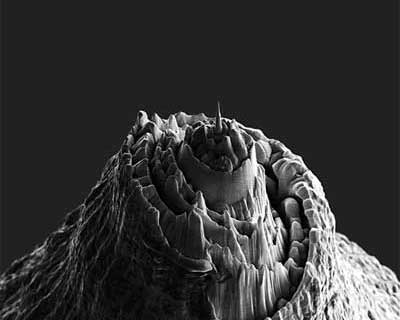
Scanning near-field optical microscopy (SNOM) makes use of nanoscale metal tips to scan a surface. Here, a standard tip has been modified & sharpened to increase its precision. The tip in the midst of this structure measures a few tens of nanometers. (Picture: G.C. Gazzadi, S3 (INFM-CNR), Modena; P.Gucciardi, CNR-IPCF, Messina. Artwork: Lucia Covi)
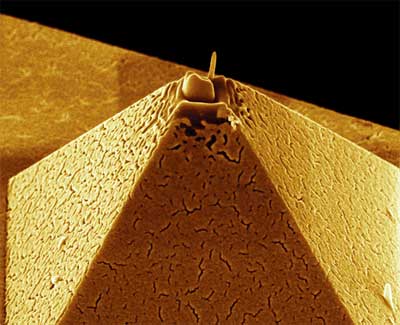
Developing new instruments to be able to "see" at the nanoscale is a research field in itself. Shown here is the tip of an atomic force microscope (AFM), of the foremost tools for imaging, measuring & manipulating matter at the nanoscale. Here, a platinum electrode measuring hundredth of a nanometer has been deposited on the tip of this pyramid formed AFM tip by focused ion beam (FIB) deposition. (Picture: C. Menozzi, G.C. Gazzadi, S3 (INFM-CNR), Modena. Artwork: Lucia Covi)
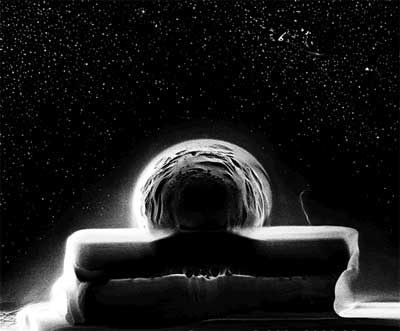
Top view of a hole carved in a polyethylene surface. During a series of experiments the use of a FIB has proven to be very versatile and capable of carving various materials, including plastic. (Image: G.C. Gazzadi, S3 (INFM-CNR), Modena. Artwork: Lucia Covi)
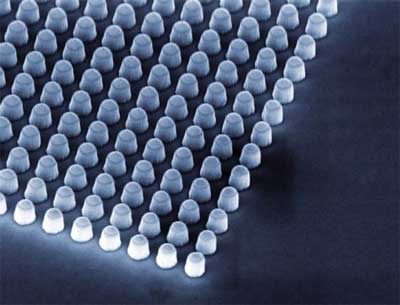
Scanning electron microscope (SEM) picture of quantum dots fabricated through electron beam lithography & later dry-chemical etching on a quasi bidimensional layer (GaAl heterostructure). These structures are used to study the behavior of electrons, which are confined in to small spaces – approximate. ten electrons per dot. The diameter of each quantum dot is 200 nm (which means that a billion of these structure basically fit on the tip of your finger). (Picture: C.P. Garcia, V. Pellegrini , NEST (INFM), Pisa. Artwork: Lucia Covi)
SEM picture of a micron sized trench (10x 20x14 µm3) in a Cu/SiO2/Si multilayer, obtained through FIB milling. The precision of this method allows the visualization of ultrathin (tens of nanometers) layers. (Picture: G.C.Gazzadi, S.Frabboni, S3 (INFM-CNR), Modena. Artwork: Lucia Covi)
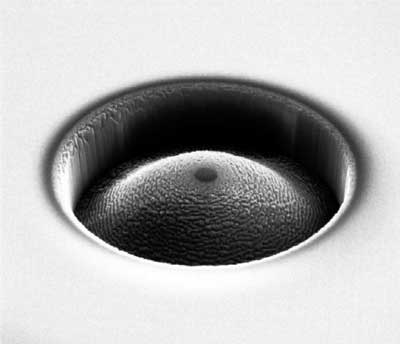
SEM picture of a work sample on a magnesium oxide surface using FIB. The diameter of the hole measures approximate. three µm. (Picture: G.C. Gazzadi, A. Spessot, S3 (INFM-CNR), Modena. Artwork: Lucia Covi)
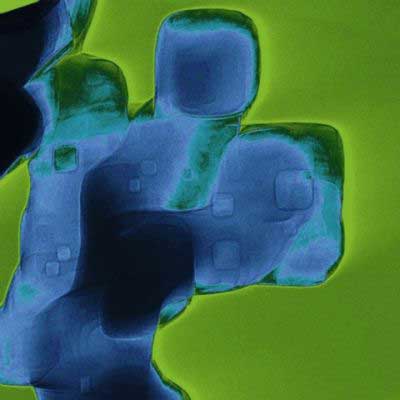
Tiny spaces have formed inside titanium dioxide nanocrystals, as shown in this SEM picture. The square structure of these inside spaces, which measure between twenty nm & 40 nm, is due to the crystalline structure of the material. (Picture: L. Nasi, IMEM (CNR), Parma. Artwork: Lucia Covi)

No comments:
Post a Comment